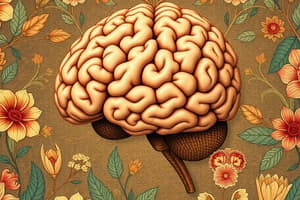Podcast
Questions and Answers
What is the function of the basement membrane in the nervous tissue?
What is the function of the basement membrane in the nervous tissue?
- Transport molecules into the interstitial fluid
- Facilitate the passage of molecules between endothelial cells
- Prevent the wrapping of astrocyte processes around capillaries
- Prevent the passage of certain solutes (correct)
What is the significance of tight junctions in the blood-brain barrier (BBB)?
What is the significance of tight junctions in the blood-brain barrier (BBB)?
- Enhance the binding of endothelial cells to astrocytes
- Prevent the passage of most molecules between endothelial cells (correct)
- Allow passage of all molecules through the endothelial cells
- Facilitate diffusion of large molecules
Which mechanism is responsible for molecules crossing the blood-brain barrier (BBB)?
Which mechanism is responsible for molecules crossing the blood-brain barrier (BBB)?
- Active transport and facilitated diffusion (correct)
- Simple diffusion by water-soluble molecules
- Vesicular transport via exocytosis
- Endothelial capillary cell contraction
Where does the blood-cerebrospinal fluid barrier occur?
Where does the blood-cerebrospinal fluid barrier occur?
What is composed of the blood-cerebrospinal fluid barrier?
What is composed of the blood-cerebrospinal fluid barrier?
How do molecules cross the blood-cerebrospinal fluid barrier?
How do molecules cross the blood-cerebrospinal fluid barrier?
What is prevented from passing between ependymal cells at the blood-cerebrospinal fluid barrier?
What is prevented from passing between ependymal cells at the blood-cerebrospinal fluid barrier?
What does vesicular transport via endocytosis refer to?
What does vesicular transport via endocytosis refer to?
In what manner does simple diffusion occur across membranes?
In what manner does simple diffusion occur across membranes?
What is the role of astrocyte processes in relation to basement membranes?
What is the role of astrocyte processes in relation to basement membranes?
Study Notes
Brain Development
- The embryonic brain develops from a tube that slowly differentiates over time.
- The embryo is initially a hollow ball of cells that eventually forms into germ layers, which give rise to all body tissues, including the nervous system.
- The nervous system develops from a tube called the neural tube, which contains a fluid-filled internal cavity called the neurocoel.
- The neurocoel forms the chambers of the adult brain where cerebrospinal fluid will flow, becoming the ventricles of the brain and central canal of the spinal cord.
Primary and Secondary Vesicles
- The head portion of the neural tube enlarges to form three primary brain vesicles:
- Prosencephalon (forebrain)
- Mesencephalon (midbrain)
- Rhombencephalon (hindbrain)
- These primary vesicles further divide into five secondary vesicles:
- Telencephalon (cerebrum)
- Diencephalon (epithalamus, thalamus, and hypothalamus)
- Mesencephalon (midbrain)
- Metencephalon (pons and cerebellum)
- Myelencephalon (medulla oblongata)
Neural Protection
- The blood-brain barrier (BBB) is composed of endothelial cells, basement membrane, and astrocyte processes.
- The BBB prevents most molecules from passing through tight junctions between endothelial cells.
- Molecules cross the BBB through vesicular transport, active transport, facilitated diffusion, and simple diffusion.
- The blood-cerebrospinal fluid barrier (BCB) occurs in the choroid plexus in the ventricles of the brain.
- The BCB is composed of endothelial capillary cells, basement membrane, and ependymal cells.
- Molecules cross the BCB through similar transportation mechanisms as the BBB.
Studying That Suits You
Use AI to generate personalized quizzes and flashcards to suit your learning preferences.
Description
This quiz covers the stages of brain development from primary and secondary vesicles in the embryonic brain to the adult structures like telencephalon, diencephalon, midbrain, metencephalon, and myelencephalon. Test your knowledge on the different regions of the developing and adult brain!




